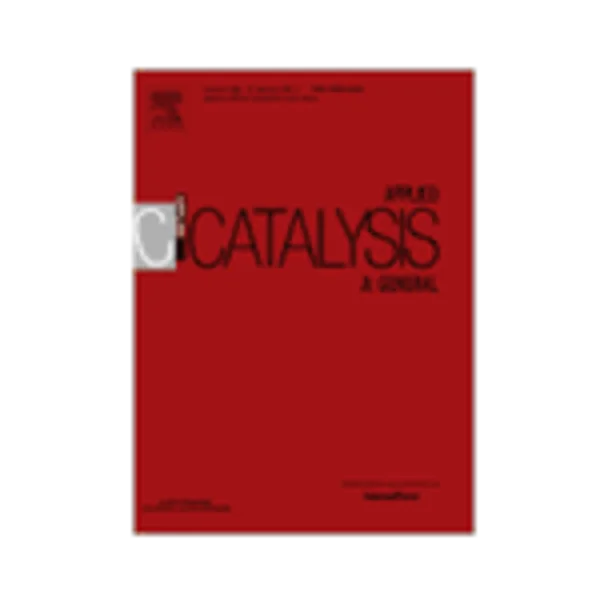-
correlation patterns and effect of syngas conversion level for product selectivity to alcohols and hydrocarbons over molybdenum sulfide based catalysts
جزئیات بیشتر مقاله- تاریخ ارائه: 1392/07/24
- تاریخ انتشار در تی پی بین: 1392/07/24
- تعداد بازدید: 995
- تعداد پرسش و پاسخ ها: 0
- شماره تماس دبیرخانه رویداد: -
the focus of the present study was to investigate the effect of the operation conditions, space velocity and temperature, on product distribution for a k–ni–mos2 catalyst for mixed alcohol synthesis from syngas. all experiments were performed at 91 bar pressure and constant h2/co = 1 syngas feed ratio. for comparison, results from a non-promoted mos2 catalyst are presented. it was found that the co conversion level for the k–ni–mos2 catalyst very much decides the alcohol and hydrocarbon selectivities. increased co conversion by means of increased temperature (tested between 330 and 370 °c) or decreased space velocity (tested between 2400 and 18,000 ml/(gcat h)), both have the same effect on the product distribution with decreased alcohol selectivity and increased hydrocarbon selectivity. increased co conversion also leads to a greater long-to-short alcohol chain ratio. this indicates that shorter alcohols are building blocks for longer alcohols and that those alcohols can be converted to hydrocarbons by secondary reactions. at high temperature (370 °c) and low space velocity (2400 ml/(gcat h)) the selectivity to isobutanol is much greater than previously reported (9%c). the promoted catalyst (k–ni–mos2) is also compared to a non-promoted (mos2) catalyst; the promoted catalyst has quite high alcohol selectivity, while almost only hydrocarbons are produced with the non-promoted catalyst. another essential difference between the two catalysts is that the paraffin to olefin ratio within the hydrocarbon group is significantly different. for the non-promoted catalyst virtually no olefins are produced, only paraffins, while the promoted catalyst produces approximately equal amounts of c2–c6 olefins and paraffins. indications of olefins being produced by dehydration of alcohols were found. the selectivity to other non-alcohol oxygenates (mostly short esters and aldehydes) is between 5 and 10%c and varies little with space velocity but decreases slightly with increased temperature. very strong correlation patterns (identical chain growth probability) and identical deviations under certain reaction conditions between aldehyde and alcohol selectivities (for the same carbon chain length) indicate that they derive from the same intermediate. also olefin selectivity is correlated to alcohol selectivity, but the correlation is not as strong as between aldehydes and alcohols. the selectivity to an ester is correlated to the selectivity to the two corresponding alcohols, in the same way as an ester can be thought of as built from two alcohol chains put together (with some h2 removed). this means that, e.g. methyl acetate selectivity (c3) is correlated to the combination of methanol (c1) and ethanol (c2) selectivities.
مقالات جدیدترین رویدادها
-
استفاده از تحلیل اهمیت-عملکرد در ارائه الگوی مدیریت خلاقیت سازمانی و ارائه راهکار جهت بهبود
-
بررسی تاثیر ارزش وجوه نقد مازاد بر ساختار سرمایه شرکت های پذیرفته شده در بورس اوراق بهادار تهران
-
بررسی تأثیر سطح افشای ریسک بر قرارداد بدهی شرکت های پذیرفته شده در بورس اوراق بهادار تهران
-
بررسی تأثیر رتبه بندی اعتباری مبتنی بر مدل امتیاز بازار نوظهور بر نقد شوندگی سهام با تأکید بر خصوصی سازی شرکت ها
-
تأثیر آمیخته بازاریابی پوشاک ایرانی بر تصویر ذهنی مشتری پوشاک ایرانی (هاکوپیان)
-
بررسی امنیت و نقش پول الکترونیکی در اقتصاد ایران
-
بررسی خواص رئولوژیکی بتن خودتراکم حاوی مواد بازیافتی pet و pvc
-
بررسی رفتار مکانیکی ستون های سنگی معمولی و مسلح شده با ژئوسینتتیک (مطالعه موردی:پی مخازن گازی پارس جنوبی)
-
بررسی سازگاری زناشویی و شادکامی در ازدواج های سنتی و غیرسنتی
-
spectral analysis of random wave uplift force on a horizontal deck
مقالات جدیدترین ژورنال ها
-
مدیریت و بررسی افسردگی دانش آموزان دختر مقطع متوسطه دوم در دروان کرونا در شهرستان دزفول
-
مدیریت و بررسی خرد سیاسی در اندیشه ی فردوسی در ادب ایران
-
واکاوی و مدیریت توصیفی قلمدان(جاکلیدی)ضریح در موزه آستان قدس رضوی
-
بررسی تاثیر خلاقیت، دانش و انگیزه کارکنان بر پیشنهادات نوآورانه کارکنان ( مورد مطالعه: هتل های 3 و 4 ستاره استان کرمان)
-
بررسی تاثیر کیفیت سیستم های اطلاعاتی بر تصمیم گیری موفق در شرکتهای تولیدی استان اصفهان (مورد مطالعه: مدیران شرکتهای تولیدی استان اصفهان)
-
تاثیر ابعاد کیفیت اپلیکیشن های موبایل بر رضایت و وفاداری کاربران
-
روند خاص پولدار شدن و کسب درآمد حرفه ای
-
بررسی رابطه توزیع درامد با وضعیت بهره مندی از آموزش عالی شهروندان استان اردبیل
-
بررسی عوامل موثر در سیاست راهبردی برون سپاری خدمات دولتی بر اساس مدل کرمیک (مطالعه موردی: سازمان ثبت اسناد و املاک کشور)
-
green envelop impact on reducing air temperature and enhancing outdoor thermal comfort in arid climates




سوال خود را در مورد این مقاله مطرح نمایید :